Related Research Articles

Railway preservation in New Zealand is the preservation of historically significant facets of New Zealand's rail transport history. The earliest recorded preservation attempt took place in 1925, although the movement itself did not start properly until 1960.

Rail transport in New Zealand is an integral part of New Zealand's transport network, with a nationwide network of 4,375.5 km (2,718.8 mi) of track linking most major cities in the North and South Islands, connected by inter-island rail and road ferries. Rail transport in New Zealand has a particular focus on bulk freight exports and imports, with 19 million net tonnes moved by rail annually, accounting for more than half of rail revenue.

The Main North Line between Picton and Christchurch and the Main South Line between Lyttelton and Invercargill, running down the east coast of the South Island of New Zealand, are sometimes together referred to collectively as the South Island Main Trunk (SIMT). Construction of a line running the length of the east coast began in the 1860s and was completed all the way from Picton to Invercargill in 1945; the last sections being on the Main North Line south of Picton. The designation "South Island Main Trunk" originally referred to only that line between Christchurch and Invercargill.

The Main South Line, sometimes referred to as part of the South Island Main Trunk Railway, is a railway line that runs north and south from Lyttelton in New Zealand through Christchurch and along the east coast of the South Island to Invercargill via Dunedin. It is one of the most important railway lines in New Zealand and was one of the first to be built, with construction commencing in the 1860s. At Christchurch, it connects with the Main North Line to Picton, the other part of the South Island Main Trunk.

The NZR K class of 1877 was the first example of American-built locomotives to be used on New Zealand's rail network. Their success coloured locomotive development in New Zealand until the end of steam.

The Plains Vintage Railway & Historical Museum is a heritage railway and recreated historic village in the Tinwald Domain, Tinwald, New Zealand. The railway runs on approximately three kilometres of rural railway line that was once part of the Mount Somers Branch. The village and railway are open regularly to the public. The railway utilises preserved and restored locomotives and rolling stock once used on New Zealand's national railway network, while the village shows visitors how life was lived in New Zealand's pioneering past.
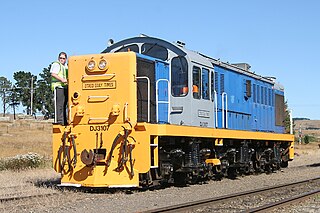
The New Zealand DJ class locomotive is a type of diesel-electric locomotive in service on the New Zealand rail network. The class were built by Mitsubishi Heavy Industries and introduced from 1968 to 1969 for the New Zealand Railways Department (NZR) with a modernisation loan from the World Bank to replace steam locomotives in the South Island, where all of the class members worked most of their lives. Nine of the locomotives remain in use, mainly with Dunedin Railways.
The Southerner was a passenger express train in New Zealand's South Island between Christchurch and Invercargill along the South Island Main Trunk, that ran from 1970 to 2002. It was one of the premier passenger trains in New Zealand and its existence made Invercargill the southernmost passenger station in the world. The service will return for a limited time in 2025.
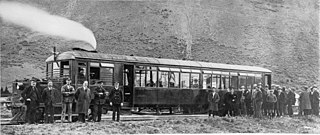
The NZR RM class Clayton steam rail motor was a unique railcar that was operated by New Zealand Railways (NZR) for New Zealand's national rail network and one of only two steam railcars to operate in New Zealand - the other being 1925's RM class Sentinel-Cammell.

The NZR RM class Midland railcar was the first successful railcar, and first diesel-powered vehicle, to enter revenue service in New Zealand. Two were built, RM 20 and RM 21, and they ran for five years from 1936 to 1941 before being replaced by larger Vulcan railcars. They operated primarily on the Midland Line and the Greymouth-Hokitika portion of the Ross Branch
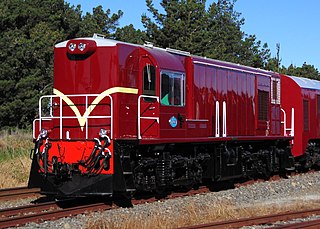
The New Zealand DI class locomotive was a class of diesel-electric locomotive in New Zealand. They were built by English Electric at their plant in Rocklea, Queensland in Australia. The class is very similar to the Queensland Railways 1620 class locomotives. At the time of their introduction, the class was seen as an alternative to the DB class for use on lightly laid secondary and branch lines, more so in the South Island. The World Bank financed introduction of the Japanese built DJ class in 1968, which ensured that no further DI class locomotives were purchased by New Zealand Railways.
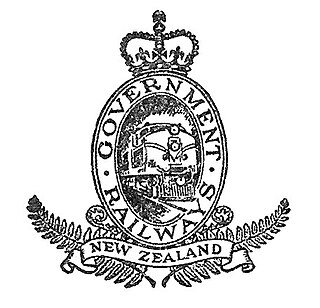
The New Zealand Railways Department, NZR or NZGR and often known as the "Railways", was a government department charged with owning and maintaining New Zealand's railway infrastructure and operating the railway system. The Department was created in 1880 and was corporatised on 1 April 1982 into the New Zealand Railways Corporation. Originally, railway construction and operation took place under the auspices of the former provincial governments and some private railways, before all of the provincial operations came under the central Public Works Department. The role of operating the rail network was subsequently separated from that of the network's construction. From 1895 to 1993 there was a responsible Minister, the Minister of Railways. He was often also the Minister of Public Works.
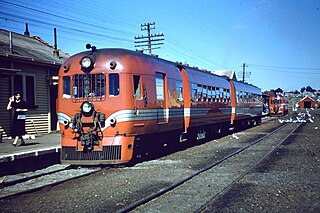
The NZR RM class 88-Seaters were a class of railcar used in New Zealand. New Zealand Government Railways (NZR) classified them as RM (Rail Motor), the notation used for all railcars, numbering the 35 sets from RM100 to RM134. They were the most numerous railcars in NZR service. Their purchase and introduction saw the demise of steam-hauled provincial passenger trains and mixed trains, and was part of a deliberate effort to modernise NZR passenger services at a time of increasing competition from private motor vehicles. Being diesel powered and lighter the railcars were less expensive to operate and able to maintain quicker timetables, although they became plagued with mechanical and electrical problems, with a number of the classes eventually being turned into depowered locomotive-hauled carriages and reclassified as the AC class "Grassgrubs".

The NZR JA class was a class of fifty-one 4-8-2 steam locomotives operated by the New Zealand Railways Department (NZR). The locomotives were built in two batches; the first batch was constructed at the Hillside Workshops at Dunedin between 1946 and 1956, while the second batch was constructed by the North British Locomotive Company (NBL) of Glasgow, Scotland in 1951. To differentiate between the two batches, the locomotives were identified by their builder.

The NZR G class was a type of Garratt locomotives used in New Zealand, later rebuilt as Pacific type locomotives. They were the only Garratt type steam locomotives ever used by the New Zealand Railways (NZR). They were ordered to deal with traffic growth over the heavy gradients of the North Island Main Trunk (NIMT) and to do away with the use of banking engines on steep grades. They were one of the few Garratt designs to employ six cylinders. A mechanical stoker was used to feed coal into the locomotive. The locomotives lasted longer in rebuilt form as standard Pacific locomotives than they did as Garratts, but their numerous mechanical issues lead to their final withdrawal following a union ban on their use in 1956.

The NZR J class was a class of forty 4-8-2 steam locomotives operated by the New Zealand Railways Department (NZR). Although designed to work on the lighter secondary lines, the class was frequently used on mainline express passenger trains as well as freight. When first introduced, the class boasted distinctive streamlining, which was later removed from 1947 onwards for maintenance reasons. Three of this class remained in service until the end of steam operation on 26 October 1971, when they were withdrawn and entered into preservation. This class should not be confused with the earlier J class from 1874.
The New Plymouth Night Express was a passenger express train operated by the New Zealand Railways Department (NZR) that ran between Auckland and New Plymouth. It ran in various forms from 1933 until 1983, though the Express designation was lost in 1956 and later incarnations did not operate at night and terminated in Taumarunui rather than Auckland. The New Plymouth Night Express should not be confused with the New Plymouth Express that operated between New Plymouth and Wellington.
The Wairarapa Mail was a passenger train operated by the New Zealand Railways Department (NZR) between Wellington and Woodville, continuing on to Palmerston North as a mixed train. It ran from 1909 until 1948 and its route included the famous and arduous Rimutaka Incline.

Lyttelton Line is a name sometimes used to refer to the section of the Main South Line in New Zealand's South Island between Lyttelton and Christchurch, and can also be used to refer to the operations on this section. As it has always been part of the Main South Line, this name has never been officially used to refer to the track itself.
NZ Rail 150 was a celebration of 150 years of Rail transport in New Zealand, held in 2013 which was 150 years since the first public railway opened at Ferrymead in Christchurch.
References
Citations
- ↑ J.Stichbury.Express freight trains in NZ in NZ Railway Observer. V80.No 383. Feb 2024, p248
- ↑ T.McGavin Ed. 1952 NZR South Island Working Timetable
- ↑ "THE NIGHT EXPRESS. (Press, 1928-06-14)". paperspast.natlib.govt.nz National Library of New Zealand. Retrieved 30 April 2017.
- ↑ "Popular Innovation – Night Expresses in South Island – The First Trains: The New Zealand Railways Magazine". nzetc.victoria.ac.nz. 2 July 1928. Retrieved 30 April 2017.
- ↑ "RAILWAY SLEEPING CARRIAGES (Press, 1935-11-28)". paperspast.natlib.govt.nz National Library of New Zealand. Retrieved 30 April 2017.
- ↑ "RAILWAY TIME-TABLE (Press, 1943-04-28)". paperspast.natlib.govt.nz National Library of New Zealand. Retrieved 30 April 2017.
- ↑ NZPD 11/7/79, Questions by Caygill(Lab-St Albans) and Holland (Nat-llam) to Acting Min or Railways and 30 on 14/9/1979,NZPD Question J. Kirk(Lab, Sydenham)
- ↑ New Zealand Limited Express Railway Gazette issue 586 February 1950 pages 129/130
- ↑ T.McGavin (ed) NZR South Island. Working Timetable, Dec 1952. NZRLS (1979) Wellington
- ↑ R. Bromby. NZ Railways. Their life and Times. (2014) Highgate. Edgeclff, NSW, 39-40
- 1 2 Mahoney 1982, p. 127.
- ↑ D. B Leitch, Steam, Speed and Splendour in G. Troup. 'Steel Roads of New Zealand'. Reed (1973)Auckland,p 211-216
- ↑ G. Troup. Steel Roads of NZ. Reed. (1973)p 214-16 & I. Johnstone (narrator). Opening 144 Invercargill to Ch, 00.00-20.00 in 'Total Steam'. DVD'. NZ
- ↑ T.A. McGavin (ed) South Island Working Timetable Dec 1952. NZLRS (1979) Wellington
- ↑ E.McQueen, NZR Mgmt 1980
- 1 2 Mahoney 1982, p. 128-129.
- ↑ Mahoney 1982, p. 129.
- ↑ New Zealand Treasury and World Bank Correspondence, (inc internal/external and informal notes, 1967) and 27-11-67. NZR Acting GM to International Bank of Reconstruction (World Bank), inc tabulated, details of drawing WB loan re DJ purchases. DJ Purchase files National Archives, Wgtn.
Bibliography
- Mahoney, J.D. (1982). Kings of the Iron Road: Steam Passenger Trains of New Zealand. ISBN 0-86469-218-8.